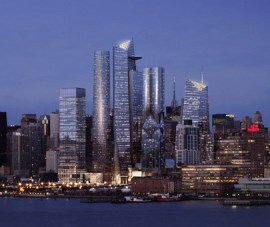
by Brianna Crandall — April 21, 2014—New York University’s Center for Urban Science and Progress (CUSP) announced on April 14 that it will partner with Related Companies and Oxford Properties Group, developers of the mixed-use Hudson Yards project, to create what the organizations call the nation’s first “Quantified Community”—a fully instrumented urban neighborhood that will measure and analyze key physical and environmental attributes.
This “Quantified Community” will create an interactive, data-driven experience for tenants and owners of the 28-acre mixed-use development now being built on Manhattan’s West Side. In line with the development’s overall aim of improving operational efficiencies, productivity and quality of life, CUSP will use the data to help New York City—and, ultimately, cities across the world—become more productive, livable, equitable, and resilient. Related and Oxford will use the data to continually improve the worker, resident and visitor experience, while also making the neighborhood more efficient.
Jay Cross, president of Related Hudson Yards, commented, “The ability to conceive of and develop an entirely new neighborhood creates tremendous opportunities. Hudson Yards will be the most connected, measured and technologically advanced digital district in the nation. Our cutting-edge commercial tenants are drawn to Hudson Yards for its state-of-the-art infrastructure featuring unprecedented wired, wireless, broadband, and satellite connectivity; and energy optimization through on-site power generation and central waste systems. Through our partnership with CUSP we will harness big data to continually innovate, optimize and enhance the employee, resident and visitor experience.”
CUSP and Related/Oxford are still developing the final list of attributes that will be measured in Hudson Yards. Examples include:
- Measuring, modeling, and predicting pedestrian flows through traffic and transit points, open spaces and retail space;
- Gauging air quality both within buildings and across the open spaces and surrounding areas;
- Measuring health and activity levels of residents and workers using a custom-designed, opt-in mobile application;
- Measuring and benchmarking solid waste with particular focus on increasing the recovery of recyclables and organic (i.e. food) waste; and
- Measuring and modeling of energy production and usage throughout the project, including optimization of on-site cogeneration plant and thermal microgrid.
Hudson Yards is planned as the largest private real estate development in the nation’s history and the largest development in New York City since Rockefeller Center. Hudson Yards is anticipated to be a hub of “connectivity, community, culture and creativity,” with more than 24 million visitors every year.
The site itself will include 17 million square feet of commercial and residential space, more than 100 shops and restaurants, approximately 5,000 residences, Culture Shed, 14 acres of public open space, a new 750-seat public school, and a 150-room luxury hotel—all offering top amenities for residents, employees and guests. According to the developers, Hudson Yards will create more than 23,000 construction jobs, and when completed in 2024, more than 40,000 people a day will either work in or call Hudson Yards their home.





